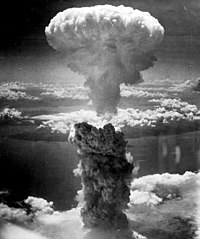
Weapon of mass destruction (WMD) is a term used to describe a massive weapon with the capacity to indiscriminately kill or incapacitate. The phrase broadly encompasses several areas of weapon synthesis, including nuclear, biological, chemical (NBC) and, increasingly, radiological weapons. There is controversy over when the term was first used, either in 1937 (in reference to the mass destruction of Guernica, Spain, by aerial bombardment) or in 1945 (with reference to nuclear weapons). Following the atomic bombings of Hiroshima and Nagasaki, and progressing through the Cold War, the term came to refer more to non-conventional weapons. The phrase entered widespread usage in relation to the U.S.-led 2003 invasion of Iraq. Terms used in a military context include atomic, biological, and chemical warfare (ABC warfare), nuclear, biological, and chemical (NBC) after the invention of the hydrogen bomb, and chemical, biological, radiological, and nuclear (CBRN), recognizing the threat of subcritical radiological weapons.
 In the history of warfare, nuclear weapons have been used only twice, both during the closing days of World War II. The first event occurred on the morning of 6 August 1945, when the United Statesuranium gun-type device code-named "Little Boy" on the Japanese city of Hiroshima. The second event occurred three days later when, again, the United States dropped a plutoniumFat Man" on the city of Nagasaki. The use of these weapons, which resulted in the immediate deaths of around 120,000 people and even more over time, was and remains controversial. dropped a implosion-type device code-named "
In the history of warfare, nuclear weapons have been used only twice, both during the closing days of World War II. The first event occurred on the morning of 6 August 1945, when the United Statesuranium gun-type device code-named "Little Boy" on the Japanese city of Hiroshima. The second event occurred three days later when, again, the United States dropped a plutoniumFat Man" on the city of Nagasaki. The use of these weapons, which resulted in the immediate deaths of around 120,000 people and even more over time, was and remains controversial. dropped a implosion-type device code-named "


